Despite the Impact of the Covid-19 pandemic, the switch to electric mobility in India made major progress, so it’s the right time to discuss the financial analysis of the electric vehicles market in India. Results of which can be seen in the increased sale of electric vehicles and electric vehicle stocks in India.
The electric vehicle sector has gained greater momentum after several central and state policies by the GOI in order to make EVs more affordable for the public and to develop a better EV charging station infrastructure across the nation.
MAJOR HIGHLIGHTS:
- The electric vehicle market share In India is expected to increase from USD 5.3 billion (2020) to USD 206 billion by 2030 which would require an investment of USD 170 billion for vehicle production and developing charging infrastructure to support the goal.
- Inlining with the goal for 2030, the demand for electric vehicle batteries would create an investment opportunity of USD 17 billion.
- To meet the goal, demand for EV charging infrastructure would create an investment opportunity of USD 3.2 billion in the electric vehicle charging stations market.
- An investment of USD 206 billion will be required from end-consumers to meet the ambitious goal of 2030.
- INR 193.57 crores given out as incentives till FY 2021 under FAME II.
- A major benefit to the electric vehicle companies in the Indian stock market by 2030.
- The global electric vehicles market is expected to reach a value of USD 725.14 billion by FY2026 which will have a major impact on the electric vehicle company shares in india.

If the goals set for 2030 are met, the Indian EV sector would grow at a CAGR of above 48% and the electric vehicle battery market would grow by 36%.
Key point :
India being the world’s largest untapped automobile EV market has allowed for 100% foreign direct investment under the automatic route without prior approval from the Reserve Bank or Government of India.
Major investment oppurtunity in the Indian EV sector.
Financial analysis of Electric Vehicles in India : EV India financial model
The future of electric vehicles in India looks promising because of the supportive government policies. This increased pace is due to the global commitments to tackle the alarming pollution levels and fuel prices.
Results of which can be seen in the incoming flow of investments for EV production as well as R&D in the electric vehicle sector along with the surge of electric vehicle shares in India
With a 30-30 EV goal, GOI aims at increasing the market share for electric vehicles to 30% by 2030 to stabilize the future scope of electric vehicles in India. Though the ambitious goal was for transition to 100% EV, 30% EV penetration seems promising and realistic.
The entire automobile industry needs to make substantial investments to meet the Goals set for 2030, which creates a great electric vehicle financial model and investment opportunities for investors in different segments of the electric vehicle sector in India.
Investment opportunities for Electric Vehicle(EV) manufacturers (OEMs)
Two-wheeler EVs being the primary driver of EV sales, may contribute to 90 percent of EV sales and major sectors to bring in electric vehicle investment opportunities in India. The production of two-wheeler EVs at such a massive scale would require an investment of about INR 1,35,100 crores (USD 19 billion) by FY 2030.
The production of four-wheeler EVs would require an investment of about INR 5,16,100 crore (USD 74 billion) by FY 2030 to meet the set target of 30% new EV sales by 2030.
Over a period of 9 years FY2021-FY2030, the transition to electric mobility and to reach the projected EV sales, the overall production cost and investment required would be INR 12,39,800 crore (USD 177 billion).
Here are the investment opportunities in different electric segments in India:
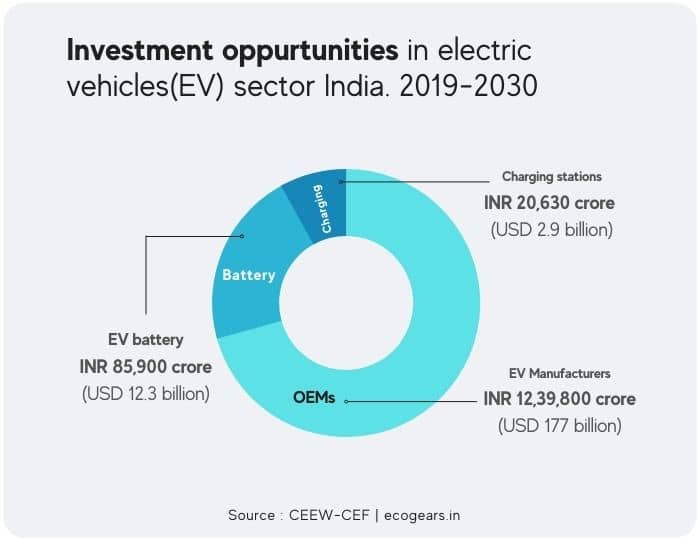
Investment opportunities in the Electric Vehicles (EV) battery manufacturing segment in India.
The transition to electric mobility is likely to create a demand for EV batteries which is a major and common component for all electric vehicles. To meet the 2030 goals, the estimated battery requirement is 158GWh annually. The demand for battery capacity will create a huge rise in the electric vehicle battery manufacturer’s stocks in India by 2030.
To meet this growing demand, battery manufacturers will need to substantially level up their production capacity, which will require huge electric vehicle investment opportunities of about USD 17 billion, if manufactured indigenously.
Investment opportunities in the EV charging station infrastructure development.
The development of a proper nationwide electric vehicle charging station infrastructure is the key to meet the ambitious goal of EV adoption by FY2030. This ambitious goal will create a huge opportunity for investment in the electric vehicle charging stations market in India across different EV segments.
Setting up charging stations across major urban areas and highways across the country would require an investment of about INR 20,630 crore (USD 2.9 billion) until 2030.
In order to support the EV adoption goal set by the government of India, India would need 29,34,000 Public EV charging stations by 2030. Out of these, it is expected that 68% of chargers will be slow AC chargers used for charging two-wheelers and three-wheelers. The estimated investment required to develop the electric vehicle charging stations market is USD 2.9 billion.
It is the right time to invest in the EV Charging station business in India.
Fill out the form below to install an EV charging station in India:
Current scenario of electric vehicles in India:
In order to cope up with the setback to EV adoption goals caused by the covid-19 outbreak, the Government of India decided to extend the FAME II policy with an outlay of INR 10,000 crore by 2 years till 31 March 2024. The scheme was launched to incentivize EV buyers, manufacturers, and station providers with an aim to make electric vehicles more affordable for the public.
Alarming pollution levels and international commitments to reduce it, resulted in the implementation of several states and central EV policies for the nationwide transition to electric mobility by 2030. Major ones include FAME II and Niti Ayog, which aim to make India a major hub for electric vehicle production by 2030.
India being the world’s largest untapped electric vehicles market recently allowed for 100% direct foreign investment under automatic route. It creates a pool of opportunities for investors to invest in the electric vehicle market share in India for the production of EVs as well as the development of charging infrastructure. This shift to electric mobility will create a major impact on electric vehicle shares in India.
Electric vehicle market segments in India
The Electric Vehicle market in India is segmented based on the type of vehicles and the power source for the vehicles.
EV market segment by the power source to the vehicle:
- Battery Electric Vehicles (BEV)
- Hybrid ELectric Vehicles (HEV)
- Plugin Hybrid ELectric Vehicles (PHEV)
EV market segment by vehicle type:
- Two-wheelers and three-wheelers
- Passenger four-wheelers
- Commercial four-wheelers and heavy-duty vehicles.
Here is the segment-wise domination of different EVs in the Indian EV market:
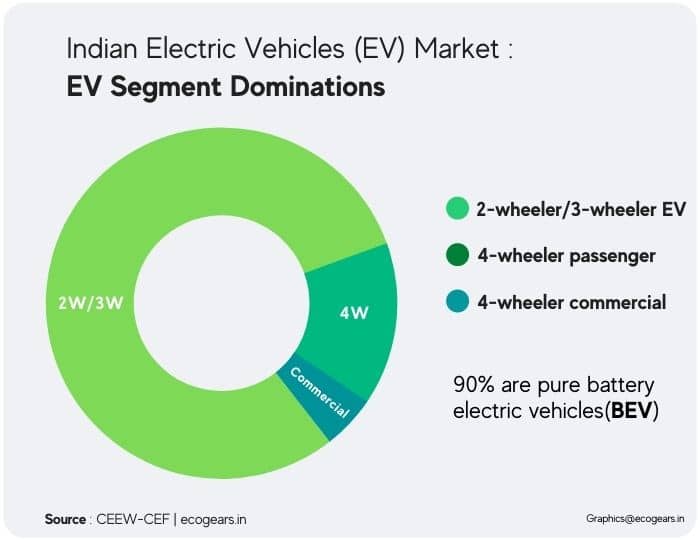
Total number of electric vehicle sales in india:
Electric vehicle sales figures in India reached new heights after heavy incentives were outlaid under government policies like FAME II for EV buyers, EV manufacturers, and charging station providers.
According to the stats of CEEW-CEF, a total of 1,21,815 electric vehicles were sold in FY 2021-FY 2022. Out of which 57,043 were 2-wheelers, 58,396 were 3-wheelers, 4,726 were 4-wheelers, and 910 were goods and heavy-duty electric vehicles.
Electric Vehicle sales by manufacturers reportedly increased post-pandemic scenario which shooted up Electric vehicles stocks listed in the stock market.
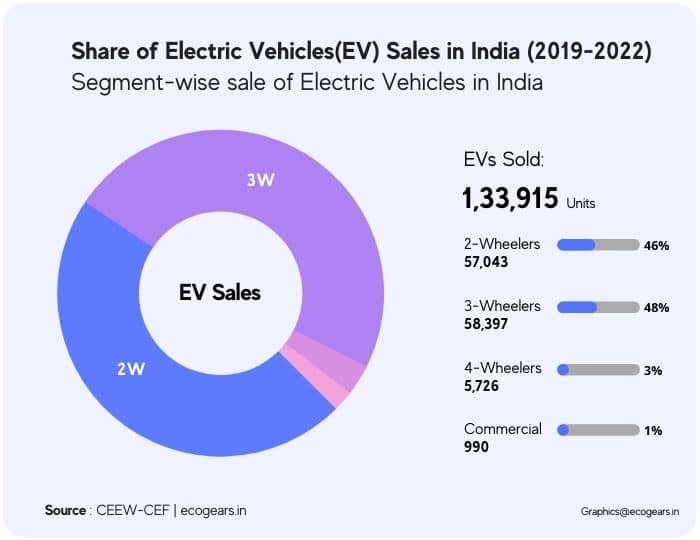
Here is the segment-wise sale of electric vehicles in India between 2019-2022:
| Vehicle Type | Electric Vehicles Sold |
|---|---|
| two-wheeler EVs | 57,043 |
| three-wheeler EVs | 58,297 |
| four-wheeler EVs | 5,726 |
| Commercial EVs | 990 |
State wise electric vehicles (EV) sales in India
Out of the total EV sales during FY2020 – FY2022, Uttar Pradesh tops the list with 24% of the total EV sales registered in India, followed by Bihar and Karnataka with 8% and 7% respectively. The impact of incentives provided by the state EV policies could be seen with the rise in the sales of electric vehicles in India.
India’s push towards the electrification of electric buses has led to the sale of more than 6000 electric buses as of January 2022. Delhi alone has a fleet of 2500 electric buses now.
Electric vehicles sales in India in 2020-2022:
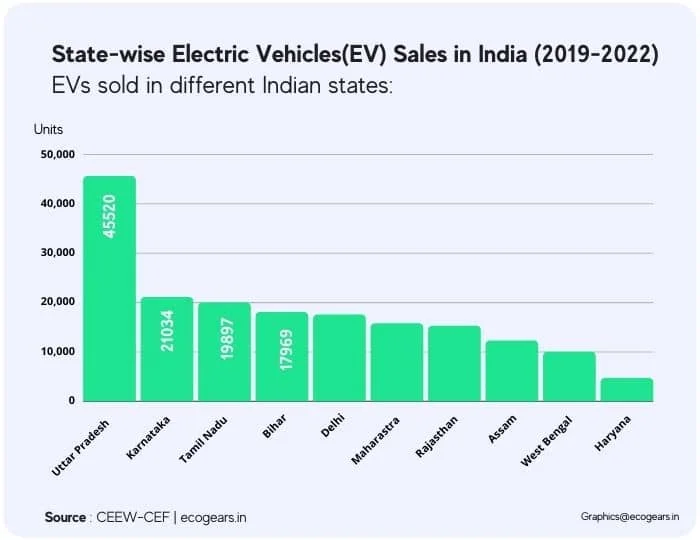
Here is the state-wise sale of Electric Vehicles in India between 2019-2022:
| States | State-wise EV sales |
|---|---|
| Uttar Pradesh | 45,520 |
| Karnataka | 21,034 |
| Tamil Nadu | 19,897 |
| Bihar | 17,969 |
| Delhi | 17,480 |
| Maharastra | 15,719 |
| Rajasthan | 15,181 |
| Assam | 12,233 |
| West Bengal | 9,923 |
| Haryana | 4,633 |
Electric vehicle market in India Sales Trend:
In wake of recent government policies, many new startups have emerged and major R&D from the automotive giants. This gave rise to a trend in the sale of electric vehicles in India. Some of them are:
Growth of electric two-wheeler market share in India.
Two-wheeler EVs being the primary driver of EV sales, contributes about 90% of total electric vehicle sales in India. With the growing fuel prices, lots of people are switching over to electric two-wheelers as means of short urban commute with the 34 available models approved under FAME II guidelines.
A major hike in the sale of electric two-wheeler sales in India could be seen after GOI decided to switch from BSV to BSVI, which raised the price of ICE two-wheelers by 8-16%.
The recent two-wheeler launch by Ola electric made a great impact on the electric vehicle stocks in India.
With a growth rate of 49% in FY2021, a total of 39,875 electric two-wheelers were sold in FY2021-FY2022. Out of which Hero electric sold the maximum number of two-wheeler EVs attaining 37% of market share, followed by Okinawa, Ampere, and Ather.
Graphical representation of the year-wise electric two-wheeler sales in India:

Electric two-wheeler sales in India in 2109-2022:
| Year | Electric two-wheeler sales |
|---|---|
| FY 2019 | 24,852 |
| FY 2020 | 26,679 |
| FY 2021 | 39,845 |
| FY 2022 | Expected to cross 50,000 |
Electric Three-Wheelers and electric car sales trend in India.
In wake of the supportive government policies offering heavy subsidies, sales of electric cars in India and three-wheelers surged significantly. According to CEEW-CEF, companies sold more than 5,727 electric cars and 58,396 three-wheelers in FY2021 – FY2022.
Incentives offered by the government for the production of EVs and deployment of electric vehicle charging infrastructure under FAME policies have made a great impact on the total number of electric car sales in India and the transition to the EV ecosystem in India.
IN FY2019-FY2022, more than 6,798 electric buses were sold in India with the push of the government for the electrification of public transport. Delhi alone has a fleet of 2700 electric buses as of January 2022.
Targeted future of electric vehicles in India : Governmental EV Growth projections.
Target EV30-30
In order to fulfill the international commitment to reduce vehicular pollution, the Government of India has set an ambitious target for 100% transition to electric mobility and 30% of vehicle sales in India to be electric by 2030 which reflects the growth of EVs in India.
In order to meet the set goal, GOI planned to achieve 450GW renewable energy capacity by 2030.
Indian EV policies and subsidies
To reduce the initial cost of owning an EV and developing the charging infrastructure to support the EV adoption, GOI implemented a certain government subsidy on electric vehicles.
READ MORE: State-wise Electric Vehicle (EV) policies and subsidies in India
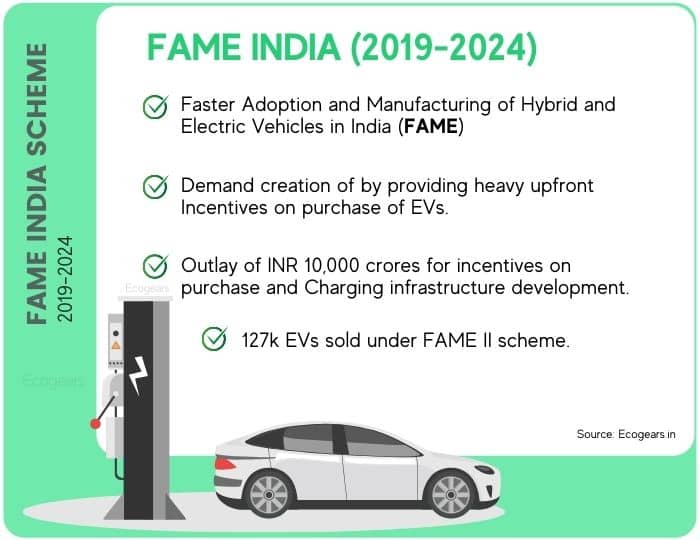
Following are the major electric vehicle schemes and policies in India:
FAME I
Launched in April 2015, the Faster Adoption and Manufacturing of Hybrid and Electric Vehicles in India (FAME) scheme aims to promote the manufacturing of electric and hybrid vehicles and the electric car subsidies in India
FAME 1 scheme mainly focused on demand creation and charging station development, which was implemented by providing government subsidies for electric vehicles in India.
FAME II
With an outlay of INR 10,000 crores FAME II scheme India was launched in April 2019 for a period of 3 years. The policy mainly focused on creating demand for EVs by providing heavy incentives on the purchase of electric two-wheelers, three-wheelers, electric cars.
CHECK OFFICIAL WEBSITE : Ministry of Heavy Industries
Because of its far-reaching impact on the Indian EV sector, the FAME II scheme was recently extended by 2 years till March 2024.
State-wise electric vehicle policies and subsidies
In line with the central electric vehicle policies, many state governments have launched their Electric vehicle policies. Over 28 states in India have already drafted and launched their respective EV policies for the transition to electric mobility. These EV India policies aimed at creating better infrastructure for EV deployment and production managed to make a great impact on the overall nationwide EV sales in FY2019-FY2021.
Most recently electric vehicle policy was launched by the Assam government in September 2021 which aimed at converting 100% of public transport to electric by 2030. Officials from the Assam government say that policy will provide the highest incentives till now on the purchase of EVs, making EVs more affordable for the public.
State-wise electric vehicle policies in India (Updated List)
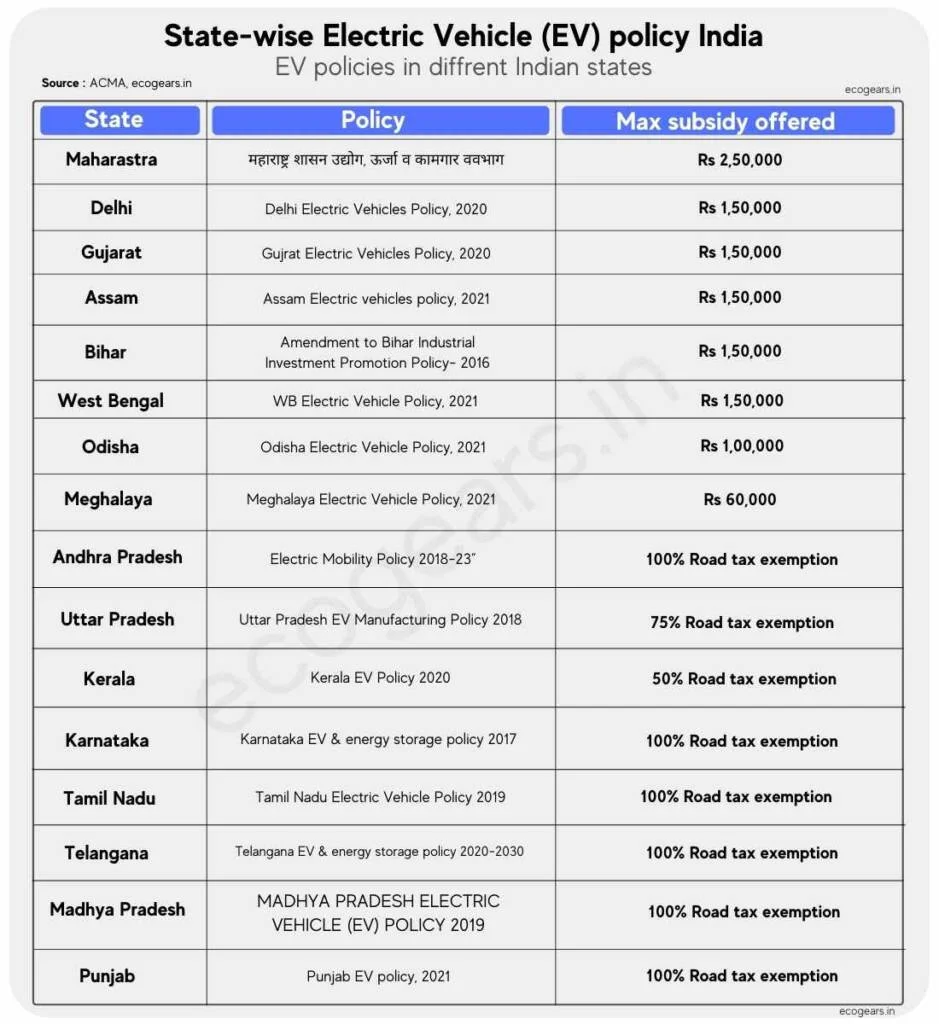
| State | Max incentives offered | Policy highlights |
|---|---|---|
| Maharastra Maharastra electric vehicle policy | Rs 2,50,000 | – Launched on July 31, 2021, & valid till March 31, 2021. – Allotted budget of INR 9.3 billion. – aim to convert 25% of public transport to electric. – Incentives for purchase and setting up EV charging stations. |
| Delhi Delhi electric vehicles policy, 2020 | Rs 1,50,000 | – Launched on August 2020 and valid till 2024. – Conversion of 50% of public transportation to electric. – aims for 25% of vehicle registration to be electric by 2024. – INR 10,000 incentive per kWh on purchase of electric cars; INR 30,000 on purchase of electric three-wheelers like e-auto and e-rickshaw |
| Gujarat Gujarat electric vehicles policy, 2020 | Rs 1,50,000 | – Launched on June 2021 and valid till July 2025. – Allotted budget of INR 8.7 billion to incentivize the purchase of over 2 Lakh EVs. – INR 10,000 incentive on the purchase of electric two-wheeler. – 100% road tax exemption. |
| Assam Assam electric vehicles policy, 2021 | Rs 1,50,000 | – Launched on September 2021 and valid till August 2026. – aims for 25% of vehicle registration to be electric by 2026. – Aims to incentivize the purchase of over 2 Lakh electric vehicles. – Incentives to be offered for EV manufacturing and charging station infrastructure. |
| Bihar Amendment to Bihar Industrial investment promotion policy-2016 | Rs 1,50,000 | – Launched on March 2019 and valid till 2022. – Maximum subsidy of INR 1,50,000. – mission to bring 100% e-mobility by 2030. – Aims to convert onroad electric rickshaws to electric by 2022. – Funds allotted to incentivize the installation of EV charging stations on Highways and commercial locations. |
| West Bengal WB Electric vehicle policy, 2021 | Rs 1,50,000 | – Launched on June 3, 2021, and valid till June 2026. – Goal for the deployment of 1 million EVs and 1 Lakh EV charging stations by 2026. – Provide free EV charging stations through local DISCOMS. – Conversion of available electric buses to electric by 2026. |
| Odisha Odisha Electric vehicle policy, 2021 | Rs 1,00,000 | – Launched on August 2021 and valid till September 2026. – aims for 20% of vehicle registration to be electric by 2026. – Maximum subsidy up to INR 100,000 on purchase of EVs. – Funds allotted to incentivize EV manufacturers and charging station providers. |
| Meghalaya Meghalaya EV policy, 2021 | Rs 60,000 | – Launched on March 2021 and valid till April 2026. – aims for 15% of vehicle registration to be electric by 2026. – Funds allotted to incentivize the expected 20,00 EVs and for the deployment of ev charging infrastructure. – All new EVs will be exempted from road tax and registration fees. |
| Andhra Pradesh Electric mobility policy (2018-2023) | 100% road tax exemption | – Launched on June 2018 and valid till July 2023. – Aims for 1 million EVs in the state by 2023. – Goal for 100% conversion of public transport and government vehicle to electric. – Aims for the deployment of 100,000 EV charging stations across the state. |
| Uttar Pradesh EV Manufacturing and Mobility policy, 2019 | 75% road tax exemption | – Launched on July 2019 Valid till august 2024. – Aims for the deployment of 1,000 electric buses and 1 Million EVs in the state by 2030. – Goal for 70% conversion of public transport to electric. – Aim for installation of 0.2 million slow and fast chargers by 2024. |
| Kerala Policy on EVs for the state of Kerala, 2019 | 50% road tax exemption | – Launched on March 2019 Valid till April 2025. – Aims for the deployment of 6000 electric buses and 1 Million EVs in the state by 2025. – Goal for setting up 70,000 EV charging stations by 2025. |
| Karnataka EVs and Energy Storage Policy, 2017 | 100% road tax exemption | – Launched on February 2017 Valid till August 2030. – Funds were allotted to incentivize the EV manufacturing segment and the deployment of 600 charging stations around Bangalore. – aims for 100% conversion of electric three-wheelers and four-wheelers to electric by 2030. – Goal for 100% conversion of public transport to electric by 2030. |
| Tamil Nadu Tamil Nadu EV policy, 2019 | 100% road tax exemption | – Launched in June 2019 and valid till April 2025. – Aims for the gradual electrification of public transport and shared mobility to electric by 2030. – 100% conversion of short urban commute like rickshaws. – 100% electricity tax exemption for EV charging stations. |
| Telengana EVs and energy storage policy Telengana, 2020 | 100% road tax exemption | – Launched on July 2020 and valid till August 2025. – aims for the sale of 80% of two-wheelers, 70% commercial vehicles, 40% electric buses, 30% private cars registration to be electric by 2026. – Goals for creating jobs for 25,000 youths in the various electric vehicle sector in Telangana. |
| Madhya Pradesh Madhya Pradesh electric vehicles policy, 2019 | 100% road tax exemption | – Launched on April 2019 valid till June 2026. – Aims for 25% conversion of public transport to electric by 2026. – 100% exemption from vehicle registration and public parking fees till 2026 for EVs. – Funds allotted for the deployment of charging infrastructure across the state. |
| Punjab Punjab ELectric Vehicles policy, 2021 | 100% road tax exemption | – Launched on November 15, 2019, and valid till December 2024. – 100% vehicle tax exemption to two-wheelers, three-wheeler EV, and electric cars. – 25% capital subsidy for the first 1000 EV charging stations in Punjab. – 100% electricity duty exemption for a period of 15 years. – Discom charge fixed at Rs 6/kW |
| Himachal Pradesh EV policy draft of Himachal Pradesh, 2019 | – Launched in September 2019 and valid till 5 years. – Aims for the 100% conversion of Public transport and private vehicles to electric by 2030. – Funds allotted for the deployment of charging infrastructure across the state. | |
| Haryana Haryana Electric Vehicle policy, 2021 | Rs 2,50,000 | – Launched on October, 2021 valid till 2029. – Aims for 100% conversion of public transport to electric by 2029. – Allows the registration of retrofitted custom electric vehicles. – Aims for the state-wise installation of charging stations at every 50 Kms by 2030. |
Electric vehicle market players, EV companies in India : Recent developments
EV adoption in India gained significant momentum as the Government along with the joint efforts of electric vehicle companies in India and startups is trying to make a major shift in the mobility pattern. Some of the recent developments in the electric vehicle industry in India and electric car companies to invest in are:
- Greaves cotton on 9th September 2021 announced its launch of multi brand electric vehicle retail store under the name of AutoEVmart.
- With an aim to incentivize high value automotive technology, the Government of India introduced the Production-Linked Incentive (PLI) scheme on 15 September 2021.
- Recently Tesla incorporated its branch in Bangalore by the name of Tesla India Motors and Energy Pvt. Ltd.
- With the introduction of Assam EV policy in September 2021, Assam plans for deployment of 200,000 electric vehicles on road by 2030.
- Kerala aims for the deployment of 1M EVs on road by 2024, and more than 600 electric buses with a view of electrifying public transport in the state.
- On 15 August 2021, Ola electric launched its first electric two-wheeler made in the largest EV factory in India. The company aims to roll out 20 Lakhs electric scooter in the India phase, priced under 1 Lakhs.
- Ola Electric supposedly made around USD 11 billion in sales booking over a purchase window of two days and a major surge in the ola electric vehicles share price. This explains the interest of the public towards Ev adoption in India.
- Telangana on 10 October, 2021 launched its first electric vehicle policy with an ambitious EV sales target of 80% by 2030.
- With regards to electric bus sales in India, more than 6000 electric buses were sold in India during FY2020-FY2021. In February 2020, Union transport minister Inaugurated the inter-city electric bus service with an aim of converting public transport to electric.
- Olectra Greentech won the bid for 100 electric buses in July 2021 for filling the gap of inter-city electric mobility.
- Ather Energy Pvt. Ltd. which had a manufacturing unit in Bangalore, built a 400,000 square feet manufacturing unit in Hosur, Tamil Nadu with an expected annual output of 10 Lakh units.
- Tata motors in August, 2021 launched its new FAME approved variant Tata tigor EV.
Barriers to EV adoption in India: Investment opportunities in electric vehicles India
India, being the world’s 3rd largest automotive industry is currently seeing a major shift to electric mobility. But the shift is not yet remarkable due to certain barriers and challenges to EV adoption, which creates an untapped opportunity for electric vehicle investment in India.
Some of the major barriers to EV adoption are:
The initial cost of owning
Currently, due to high technology costs and imported components, the initial cost of owning an electric car is quite high compared to ICE cars. Analyst at CEEW-CEF says that with R&D and indigenous manufacturing of EV parts, the cost of EV can be reduced significantly. It creates an opportunity for investors to invest in startups and EV giants for R&D and production.
Lack of charging infrastructure
Currently, there are 934 EV public charging stations in India compared to million in other countries which shifted to electric mobility. Andhra Pradesh has the highest number of charging stations with a market share of 46.8%. In order to meet the goal of 2030, India will require 29,37,800 Public Charging Stations. Lack of charging infrastructure is a major reason why the shift is slow in India.
Limited models and range anxiety
Currently, India has around 19 FAME-approved electric car models, and 34 electric two-wheeler models. But most of them are not accessible to the public or not produced on a large scale. Indians have huge anxiety over the driving range, which as of now is quite less in India due to technological barriers and charger availability.
Ecogears take :
The bottom line for the EV adoption in India hugely depends on the flow of investment to the OEMs, battery manufacturers, and charging station providers in order to scale up the production and deployment of proper charging infrastructure.
In order to meet the 30% EV sales by 2030, India needs to achieve the power capacity of 158 Gwh and 29,37,800 public charging stations.
With the supportive government policies and allowance of 100% foreign investors via automatic route, the goal for EV transition seems to be achievable.

